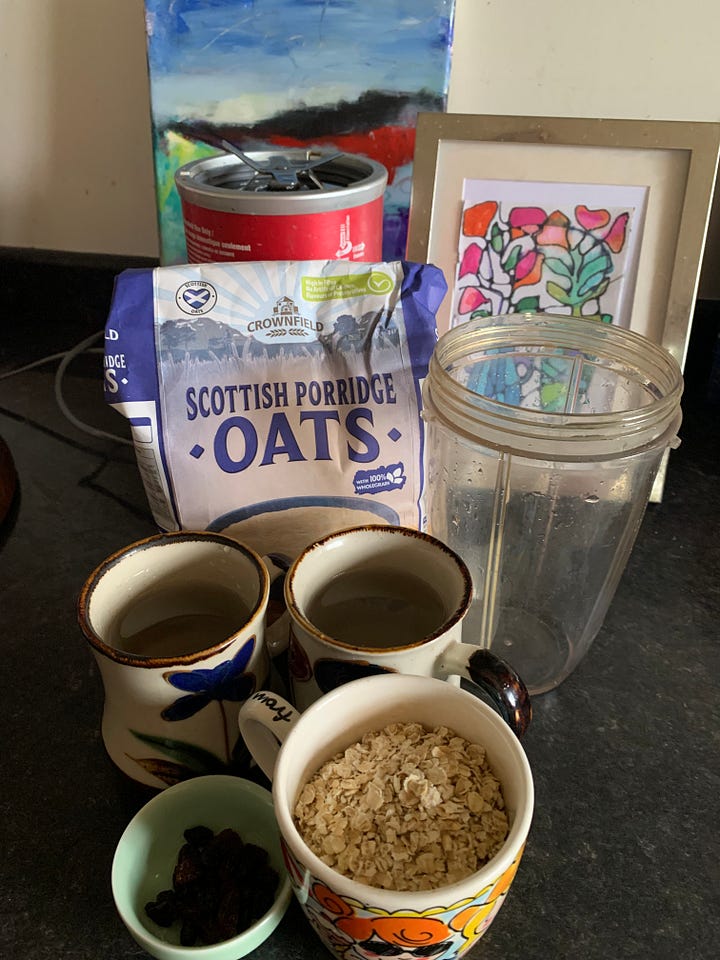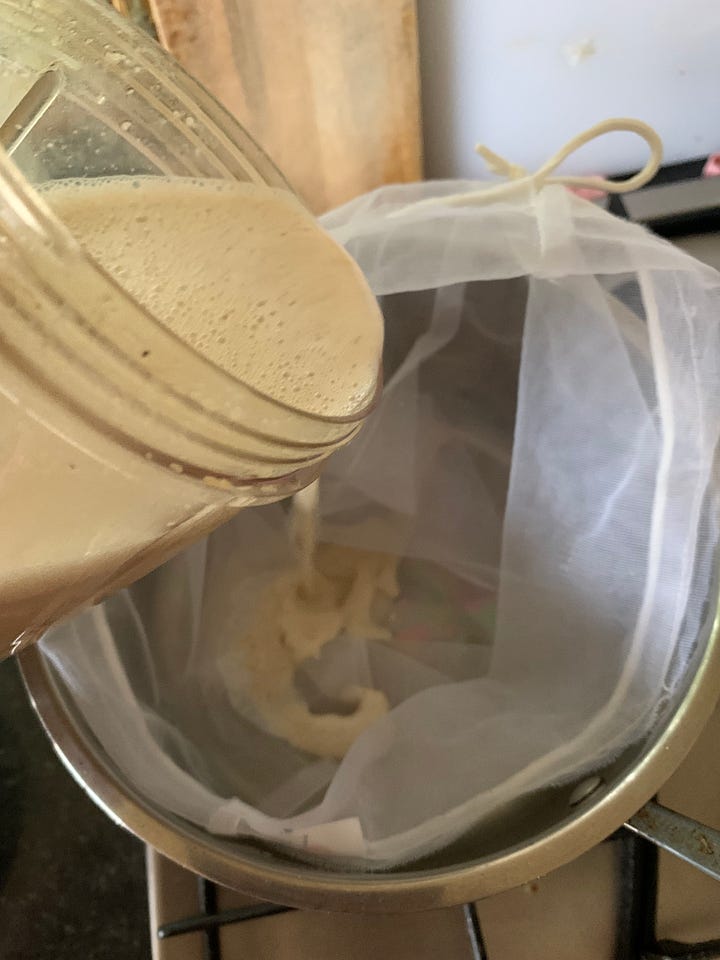Trauma survivors and the fear of stillness Chapter 36 Naked truth
When silence is not an option and a Soul to soul recipe to break the anxiety circle

Spring was in the air, Martha thought as she wrapped her hands around the warm mug of coffee. The color was different—darker than usual. The milk wasn’t the same either. Oat milk. She had made it that way today. Give it a try as you might be surprised. It is pretty good. Martha is using creative cooking as an anxiety breaker cycle.
Why did you do that? The Ferret’s voice echoed in her mind. What is this ridiculous thing you’re trying now?
It was always the same. Whenever Martha experimented with something new, the Ferret was there—ready to criticize, ready to ridicule. The Ferret despised change, resented innovation of any kind. To her, it was a threat—an attack on the familiar, on what she could control.
A cold shiver ran down Martha’s spine. She exhaled sharply and shook out her hands, just like she had learned from a YouTube video. Shake it, shake it… let it go.
Earlier that day, she had come across an article about trauma survivors and their relationship with noise. The topic had always fascinated her—she had thought about it countless times.
GROWING UP
Growing up, noise had been a constant companion. Each morning, the first thing she did was press play. Her cassette-radio player was her refuge, filling every corner of her world with sound. She had loved music, craved it, and longed to take it everywhere. She adored radio plays, especially the funny programs broadcast on Saturdays and Sundays. In those days, a golden generation of actors and actresses brought laughter to the nation, helping people see life in different colors, helping them laugh—and in doing so, live.
Little did she know that after the revolution, everything would change. Humor, as she had known it, died a slow death, replaced by risqué jokes, less talent, more crudeness—soulless and empty. The revolution had opened up a box full of wanted and unwanted gifts. Wrapped up nicely, but time would reveal their emptiness—plenty of form, but little substance.
She still remembered Ann, her schoolmate who had been adopted. Ann once told her that her father loved her so much that he would carry her half-asleep into the bathroom, letting her listen to music as she slowly woke up.
Martha could picture it vividly—Ann, drowsy and safe, wrapped in the warm arms of a father she adored, the gentle hum of music in the background. A scene filled with tenderness, warmth, and a love Martha had never known.
AN EMPTY FLAT
She, on the other hand, came home to an empty flat. A latchkey kid. A real one. No father, no mother, no grandmother or grandfather, no uncles, aunts, or nannies to pick her up from school, prepare lunch, or take her for ice cream. Nobody. This was the reality of a latchkey child.
And so, the radio and her books became her closest companions. Neither ever betrayed her.
Noise became the antidote to loneliness, the unpaid nanny, the shield against creeping fear. Darkness brought with it an anxious stillness, the city outside growing quiet while inside, she sat alone. Her parents were often late. Each half-hour that passed without them added another layer to her anxiety. Sometimes, her mother was stuck in yet another queue for whatever essentials were being sold that day—chicken legs, liver, oil, cheese. Other times, she was meeting with the divorce lawyer, preparing for yet another defense. As for her father, maybe he was with his mistress. Maybe he was lingering over a long dinner with colleagues, delayed by laughter and wine.
Meanwhile, Martha sat at home, studying, reading—always with noise in the background. Silence and stillness were never peaceful. They were full of fear, full of the unknown.
She studied with music in the background. It helped her concentrate. Always.
Her mother never understood that. She berated Martha constantly, accusing her of pretending to study whenever there was noise in the background. The same argument, over and over, year after year—despite Martha’s good grades, despite her passing every exam. It didn’t matter. The Ferret remained unconvinced, insisting that real studying required absolute silence.
COMPARISON HURTS
She always had a comparison ready. The girl downstairs—Mariana’s daughter, a year older, studious, obedient. She hated noise, studied in complete silence, and the Ferret admired that. She sang praises of that girl and of other children—colleagues’ sons and daughters, all of whom, in her eyes, had something Martha lacked. They were more disciplined, more graceful, more worthy. Or simply looked better.
But noise wasn’t just a study aid. It was a barrier. A shield against the chaos outside her door. It pushed the sound of her parents’ quarrels just a little further away—though never for long. The louder their voices rose, the harder the doors slammed, the tighter the knot of anxiety in her chest became. She would open her door, unable to block it out, forced again into the role of mediator between two people who loathed each other.
“I will kill you and her as well!” her mother screamed.
“I will come to your office and throw acid in her face—and yours!” her mother continued
“Love cannot be forced!” he shrieked in a voice almost breaking.
And so much more.
At night, the soothing voices of actors in radio plays helped her drift to sleep. Sometimes, she would wake at 1 a.m. or 3 a.m., the static hum of the radio still filling the room. She would reach out, switch it off, and sink back into the quiet—a quiet that never felt safe.
NOTHING HAPPENED! CARRY ON!
The next day was just like any other—wake up, get ready, go to school, come back, repeat. There were never any guarantees of peace at home. Never.
Thank God for homework. In that era, teachers assigned plenty of it, keeping students busy from one day to the next. From Year 6 onwards, extra studies were added on top of regular coursework. It was the stage when children started taking additional lessons with private tutors.
Year 8 was the first major milestone, a crucial year that determined a student’s future. It marked the first set of difficult exams for college entry, with admission based solely on performance. The competition was fierce—often five students competing for a single place. In Martha’s year, it was even tougher. She belonged to the second generation of children who couldn’t be aborted, meaning there were more students than ever, all vying for a limited number of seats.
Her life revolved around the flat, where peace was a fleeting luxury, found only in the pages of a captivating book, the depths of her studies, or the comfort of any sound—so long as it wasn’t a familiar one.
Each time she heard the key turn in the lock, she jolted, her body bracing for what was to come. The ringing of the doorbell sent a shiver through her spine—it was time to be on high alert once again, anticipating the all-too-familiar yet deeply distressing sounds: shouting, raised voices, slamming doors.
The mug is empty, and Martha reconnects with the present moment. Overwhelmed by different challenges, she knows their roots lie in the past. She often wonders how other trauma survivors experience noise—does it unsettle them as it does her?
Soul to soul recipes - break the cycle of anxiety one recipe at a time




Homemade Oat Milk Recipe
Ingredients:
1 cup rolled oats (organic if possible)
2 cups water (for a creamier texture) or up to 3 cups for a lighter version
A pinch of salt (optional)
2-3 pitted dates or a handful of raisins or 1 tablespoon maple syrup (optional, for sweetness)
½ teaspoon vanilla extract (optional, for flavor)
Instructions:
Soak (Optional but recommended for creamier milk):
Soak the oats in water for about 15 minutes, then rinse and drain them. This helps remove excess starch and prevents the milk from becoming too slimy.
Blend:
Add the oats, fresh water, and any optional ingredients (salt, dates, vanilla) into a blender. Blend on high for 30-40 seconds. Avoid over-blending, as it can make the milk too thick and gelatinous.
Strain:
Pour the mixture through a nut milk bag, fine mesh strainer, or clean cheesecloth into a bowl or jug. Squeeze or press gently to extract as much milk as possible without forcing too much pulp through.
Store & Use:
Transfer the oat milk into a sealed bottle or jar and refrigerate for up to 4 days. Shake before using, as natural separation occurs.
Tips for Best Texture:
Don’t over-blend! Over-processing can make the oat milk too thick and slimy.
Use cold water instead of warm or hot water to prevent a sticky texture.
Double strain if you want ultra-smooth milk.
Skip soaking if you prefer a thinner consistency (just rinse the oats well before blending).
For the leftover oat pulp, you can make some delicious bonbons.
Oat Bonbons Recipe
Ingredients:
1 cup of leftover oat pulp
2 tablespoons of nut butter (peanut butter, almond butter, or cashew butter work great)
2 tablespoons of honey or maple syrup (adjust to taste)
2 tablespoons of raisins or dried fruit (like cranberries, raisins, apricots), chopped if large
1/4 cup of shredded coconut (optional)
1/2 teaspoon of vanilla extract (optional)
A pinch of cinnamon or cocoa powder (optional)
A handful of crushed nuts or seeds (optional)
Instructions:
Mix the ingredients: In a bowl, combine the leftover oat pulp, nut butter, honey or maple syrup, raisins (or dried fruit), shredded coconut, vanilla extract, and any optional spices or nuts you’d like to add.
Blend until combined: Stir everything until the mixture becomes thick and sticky. If the mixture is too dry, add a little more syrup or water to help it stick together.
Form the bonbons: Take small spoonfuls of the mixture and roll them into balls. You can use your hands or a spoon to shape them.
Coat the bonbons (optional): If you'd like, you can roll the bonbons in shredded coconut, cocoa powder, or crushed nuts for an extra flavor and texture.
Chill: Place the bonbons on a tray and chill them in the fridge for at least 30 minutes to firm up.
Serve: Enjoy your oat bonbons as a healthy and satisfying snack!
Until next time, be well!
Ways you can support my work
Buy one of the creativity, mindfulness, colouring in workbooks and journals
Subscribe to my newsletter Soul to soul stories
Share this newsletter with people you think would benefit from reading it
Buy me a coffee and explore the downloadable digital products
Buy my art
Upgrade to a paid subscription
Thank you for fuelling the inspiration
The heavy coat of rejection and how to shift it one bit at a time
Rejection—a word, a feeling, a force that enters our lives in countless ways, often leaving behind pain, grief, uncertainty, and imbalance. I want to explore it through the lens of metaphor and offer an expressive art exercise to help shift its weight into something lighter, something that fosters movement, growth and self compassion.




Karina, it’s as if we lived in the same household… It (still) makes me so sad, and I wonder how many more children experienced something similar back then. I can only hope things are different now.
Sending you much love 🫶🏻
Needless to say, music saved my life too and you made me smile as I remembered how my mum was completely puzzled how I was able to study with music in the background 🙂
Karina, first of all thanks for the recipes! I'm absolutely going to try these!
Regarding noise, I'm not sure if it is universal for survivors but I definitely need music, white noise, a fan ... And sound at all to focus. With no noise I get jittery and cannot focus at all.